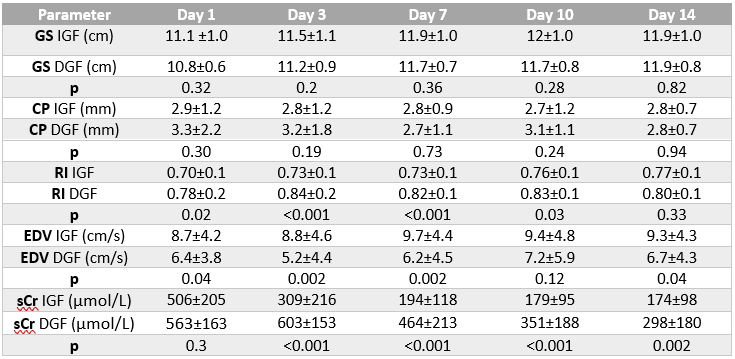Impact of delayed graft function on doppler ultrasound parameters in the early period after kidney transplantation
Karmen Romozi1, Miha Arnol1,2, Jernej Pajek1,2, Jakob Gubenšek1,2, Vladimir Premru1,2, Jadranka Buturović-Ponikvar1,2, Andreja Aleš-Rigler1,2.
1Department of Nephrology, University Medical Centre Ljubljana, Ljubljana, Slovenia; 2Faculty of Medicine, University of Ljubljana, Ljubljana, Slovenia
Background: There are few data on the evaluation of kidney transplants by serial daily Doppler-ultrasonography (US) in the early post-operative period after transplantation. The aim of our prospective observational study was to compare daily Doppler-US parameters of kidney grafts between transplant recipients with immediate graft function (IGF) and delayed graft function (DGF) and to show the correlation between Doppler-US parameters and graft function in both groups.
Methods: A total of 123 consecutive patients who received a kidney transplant between August 2015 and September 2018 were included in the study. Exclusion criteria were primary graft nonfunction, graft failure or death early after transplantation. In addition to the daily blood tests, daily Doppler-US examinations were performed on working days during the first 14 post-operative days. Serum creatinine (sCr), bipolar graft size (GS), cortical perfusion (CP), end diastolic velocity (EDV), and resistive index (RI) were compared between the IGF and DGF patient groups.
Results: Eighty-four patients were male (68%), median age was 53 (range 18-81) years, 99 patients had IGF (80%), and 24 patients had DGF (20%). Ultrasound-Doppler parameters and serum creatinine levels in patients with IGF and DGF are presented in the table. {TABLE}
During the early period after transplantation, kidney GS increased in both groups. In patients with IGF and DGF the graft was the largest on day 7 and 14, respectively. There were no differences in the CP between the groups. At all time points, patients with DGF had higher RI, lower EDV and worse graft function when compared to patients with IGF. At the end of the 2-week observation period DGF persisted in 2 patients (8%). Both patients became dialysis-independent by the end of first month posttransplant (day 24 and 25 post-transplant respectively).

Conclusion: In patients with DGF, increased RI and decreased EDV were detected on daily Doppler examination in the first 2 weeks after transplantation. No significant difference in kidney GS was found between the groups.
